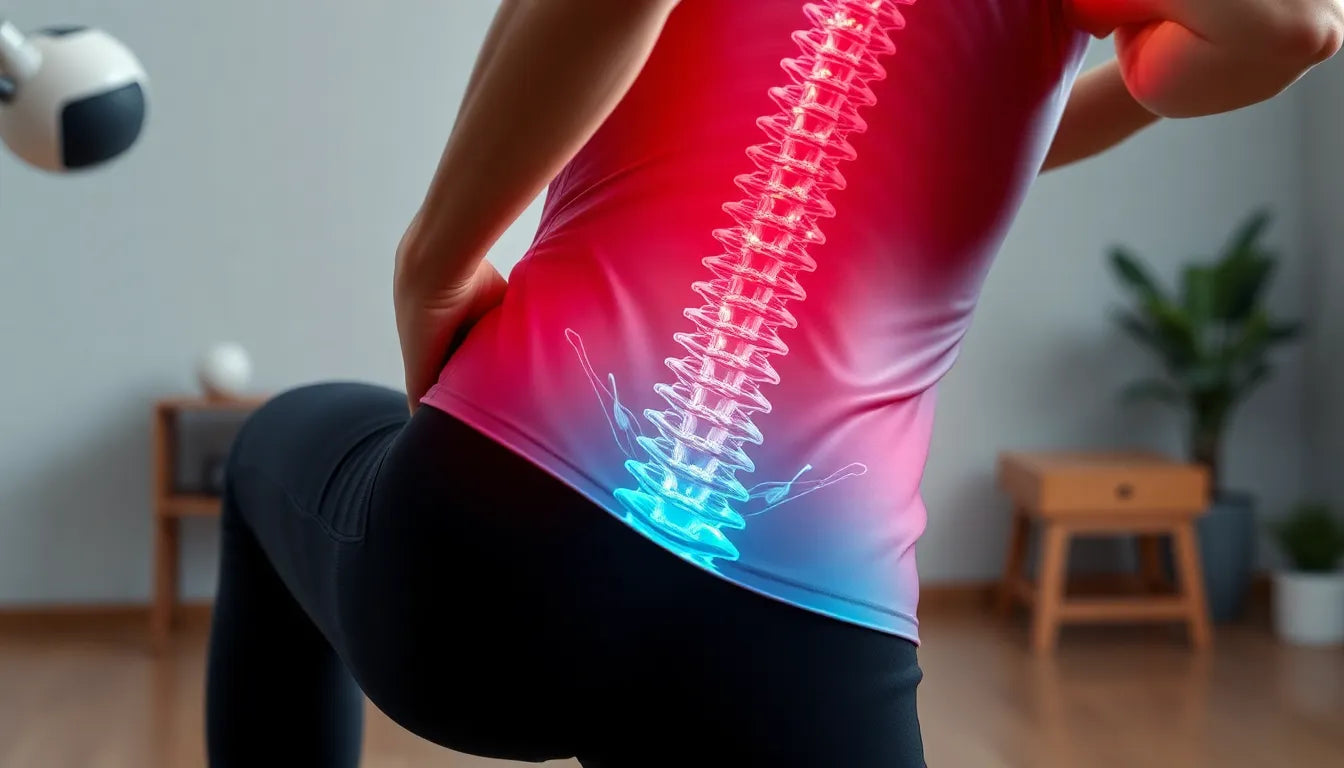Understanding the intricacies of a herniated disc is crucial for anyone experiencing persistent back pain or discomfort. A herniated disc occurs when the soft inner gel of a spinal disc pushes through a crack in the tougher exterior casing. This condition can result from wear and tear over time, or a sudden injury, and is often accompanied by symptoms like pain, numbness, or weakness in the limbs. These symptoms arise due to the pressure the herniated disc places on nearby nerves, leading to a range of discomforts that can significantly impact daily life.
Impact on daily life
Living with a herniated disc can be challenging, as it often affects one's ability to perform everyday activities. The pain and discomfort can lead to reduced mobility, making it difficult to walk, sit, or even stand for prolonged periods. This can severely impact one's quality of life, limiting participation in work, social activities, and even simple household tasks. Moreover, without proper treatment, a herniated disc can lead to more severe complications, including chronic pain and potential nerve damage. Therefore, seeking effective treatment is essential not only to alleviate pain but also to prevent further health issues.
Objective of the post
This blog post aims to guide you through the various treatment options available for herniated discs, both surgical and non-surgical. Understanding these options is vital for making informed decisions about managing your condition. Whether you're considering advanced surgical techniques or exploring non-invasive therapies, this post will provide valuable insights into the benefits and considerations of each approach. By the end, you'll be equipped with the knowledge needed to choose a treatment path that aligns with your health goals and lifestyle needs.
Surgical treatments for herniated discs
When it comes to addressing herniated discs, surgical intervention is often considered for cases where conservative treatments fail to provide relief. One of the most advanced surgical options is the endoscopic discectomy. This procedure is renowned for being ultra-minimally invasive, requiring incisions less than one centimeter. Unlike traditional methods, endoscopic discectomy offers significant benefits, including reduced pain, quicker recovery, and a faster return to daily activities. This technique utilizes a small camera and instruments inserted through tiny incisions, allowing surgeons to remove the herniated portion of the disc with minimal disruption to surrounding tissues.
In comparison, traditional surgical approaches like open discectomy and microdiscectomy involve larger incisions and more tissue disruption. Open discectomy typically requires a more extensive incision to access the affected disc, which can lead to a longer recovery period. Meanwhile, microdiscectomy uses a microscope to assist in the procedure, allowing for a smaller incision of about 2-3 centimeters. While both methods are effective, endoscopic discectomy's minimal invasiveness makes it a preferred choice for many patients seeking surgical relief.
Exploring non-surgical treatments
For those hesitant about surgery, several non-surgical treatments offer promising alternatives. Stem cell therapy is gaining attention for its ability to regenerate disc tissues using cells harvested from the patient's bone marrow or fat. This natural method not only aids in tissue repair but also reduces inflammation. However, it's important to note that stem cell therapy can be costly and is still under research for its long-term efficacy.
Another innovative option is PRP (Platelet-Rich Plasma) injections. This treatment harnesses the body's own healing powers by concentrating platelets from the patient's blood and injecting them into the affected area. Typically, 1-3 sessions are required to see noticeable improvements in pain and mobility. PRP injections are particularly suitable for mild to moderate disc issues.
Cold laser therapy is another non-invasive treatment that uses low-level light to stimulate healing at the cellular level. This therapy helps reduce inflammation and alleviate pain, offering a gentle yet effective solution for those with herniated discs.
Conservative care options
Traditional conservative care remains a cornerstone in managing herniated disc symptoms. Physical therapy is often recommended to strengthen the muscles around the spine, improve flexibility, and reduce pressure on the affected disc. Pharmacologic therapy, including the use of nonprescription pain medications, can also provide relief from discomfort.
For more severe pain, epidural steroid injections may be administered to reduce inflammation and relieve nerve pressure. These injections deliver steroids directly into the epidural space around the spinal cord, providing targeted pain relief.
Evaluating treatment efficacy
When comparing surgical and non-surgical treatments, studies have shown that lumbar discectomy is more effective than conservative care in reducing leg and back pain. Additionally, combining lumbar discectomy with annular closure has been found to decrease the risk of reherniation. Surgical interventions are generally more effective for patients who do not respond to initial conservative treatments, offering better symptom relief and a quicker return to normal activities.
Ultimately, the choice between surgical and non-surgical treatments depends on the severity of the herniated disc, the patient's overall health, and their personal preferences. Consulting with a healthcare professional is essential to determine the most appropriate approach for each individual case.
Recovery and expectations
Understanding the recovery process for herniated disc treatments is crucial for setting realistic expectations and ensuring a smooth healing journey. For those undergoing endoscopic discectomy, the recovery time is notably shorter compared to traditional surgical methods. Patients often experience a significant reduction in pain and can typically resume normal activities within a few weeks. This rapid recovery is due to the minimal tissue disruption involved in the procedure.
In contrast, traditional surgical approaches such as open discectomy and microdiscectomy may require a longer recovery period. Patients can expect to take several weeks to months to fully heal, depending on the extent of the surgery and individual health factors. During this time, adherence to post-operative care instructions is essential to facilitate healing and prevent complications.
Non-surgical treatments like stem cell therapy, PRP injections, and cold laser therapy offer varying recovery experiences. These methods generally involve minimal downtime, allowing patients to continue with their daily activities with little interruption. However, the full therapeutic benefits might take several weeks to become apparent, especially for regenerative therapies like stem cell treatment.
Cost considerations
When evaluating treatment options for a herniated disc, cost is a significant factor to consider. Endoscopic discectomy, while offering numerous benefits, can be more expensive than traditional surgeries due to the advanced technology and expertise required. However, many patients find the investment worthwhile for the quicker recovery and reduced pain.
Non-surgical treatments such as stem cell therapy and PRP injections can also be costly, with prices varying based on the number of sessions required and the specific healthcare provider. Insurance coverage for these treatments may vary, so it is advisable to check with your provider regarding potential reimbursement.
Conservative care options, including physical therapy and pharmacologic treatments, are generally more affordable and often covered by insurance. However, for long-term management, the cumulative cost of ongoing therapy sessions and medications should be considered.
Frequently Asked Questions
What are the first signs of a herniated disc?
Common signs include back pain, numbness, tingling, or weakness in the limbs.
Can a herniated disc heal on its own?
In some cases, symptoms may improve with rest and conservative care, but medical evaluation is important.
How long is the recovery period after surgery for a herniated disc?
Recovery time varies; endoscopic discectomy typically offers a faster recovery than traditional surgery.
Are non-surgical treatments effective for all herniated disc cases?
Non-surgical treatments can be effective, especially for mild to moderate cases, but severe cases might require surgery.
What steps can be taken to prevent herniated disc recurrence?
Engaging in regular exercise, maintaining a healthy weight, and practicing good posture can help prevent recurrence.
Sources
- University Hospitals. (2020). "Endoscopic Discectomy: A Minimally Invasive Solution."
- Yale Medicine. (2021). "Herniated Disc Treatment Options."
- Centeno, C. J., et al. (2018). "A Review of Stem Cell Therapy for Disc Degeneration." Journal of Orthopaedic Surgery and Research.
- Spine-Health. (2021). "Platelet-Rich Plasma (PRP) Therapy for Back Pain."
- Chow, R. T., et al. (2018). "Efficacy of Low-Level Laser Therapy in the Management of Neck Pain: A Systematic Review and Meta-Analysis of Randomized Placebo or Active-Treatment Controlled Trials." The Lancet.
- Mayo Clinic. (2022). "Epidural Steroid Injections."
- Jacobs, W. C. H., et al. (2020). "Surgical versus Non-Surgical Management of Lumbar Radicular Syndrome due to a Herniated Disc: A Systematic Review." European Spine Journal.



